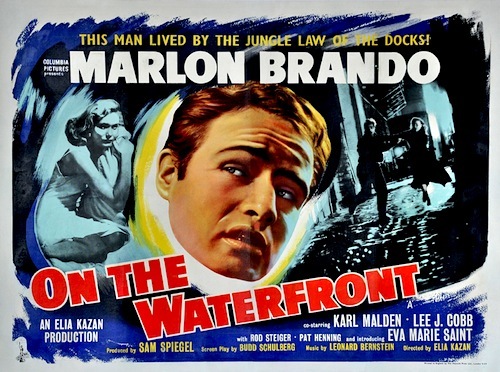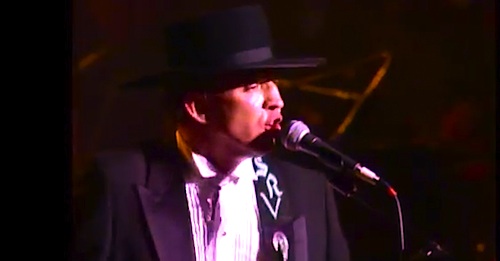[Editor’s Note: The post below appears today at The Huffington Post.]
By Govindini Murty & Jason Apuzzo. This year marks the 60th Anniversary of On the Waterfront, the winner of the Best Picture Oscar for 1954. In honor of this weekend’s Oscars, we’re taking a look at what still makes this film such a timeless classic. We had the pleasure of seeing On the Waterfront last year at the TCM Classic Film Festival with star Eva Marie Saint in attendance. It was truly a delight to hear the lovely Ms. Saint talk in person about working with such brilliant talents as Marlon Brando, Elia Kazan, and Karl Malden – and the full interview featuring Ms. Saint’s discussion with Robert Osborne, followed by screenings of three of her films, including On the Waterfront, will air March 31, 2014 on TCM.
For those unfamiliar with the film, On the Waterfront tells the story of Terry Malloy (Brando), an ex-boxer turned longshoreman who struggles with his conscience when a criminal investigation into waterfront crime puts him at odds with a corrupt union boss (Lee J. Cobb) and his own brother (Rod Steiger). Inspired by a tough local priest (Karl Malden), and stirred by a touching, guilt-ridden love affair with Edie Doyle (Eva Marie Saint), Terry eventually turns away from his complicity in waterfront crime and sparks a labor revolt against the corrupt boss.
Embraced by both audiences and critics, the gritty and emotional film was nominated for 12 Academy Awards – eventually winning eight, including the Oscars for Best Picture, Best Actor (Brando), Best Supporting Actress (Saint) and Best Director (Kazan).
Filmed documentary-style in bitter cold on location at the Hoboken docks, On the Waterfront exhibits the kind of earthy realism that many studio-bound productions of the 1950s avoided. As Kazan noted in his autobiography, “[t]he bite of the wind and the temperature did a great thing for the actors’ faces: It made them look like people, not actors – in fact, like people who lived in Hoboken and suffered the cold because they had no choice.”
The film further created a sensation due to parallels between Terry Malloy’s testimony before the film’s waterfront crime commission and Elia Kazan’s controversial appearance before the House Committee on Un-American Activities (HUAC) in 1952, during which he’d been pressured to ‘name names’ of estranged former colleagues alleged to have been communists. Indeed, On the Waterfront in its day not only became a gritty poem of the American working class, but also Kazan’s plea against conformity – both of the communist and McCarthyite variety.
Whatever one thinks of Kazan’s questionable behavior – the true motivation of which remains obscure – the artistry of his film has never been in doubt. Indeed, controversies over the film’s politics have abated in the sixty years since On the Waterfront‘s release, and what remains today is a stark, austere, almost religious masterpiece that derives its strength from the honesty of its emotions – unencumbered by the usual Hollywood trappings of celebrity narcissism, violent action or visual effects.
Indeed, seeing On the Waterfront on the Chinese Theatre’s gigantic screen during the TCM Classic Film Festival reminded us again of why simple human truth in storytelling – particularly as conveyed by expressive faces in close-up – is always so compelling. On the Waterfront emerged out of the tradition of documentary realism – standing midway between the Italian Neorealism of films like Rossellini’s Rome, Open City and Fellini’s La Strada that arose out of the ashes of WWII, and the later avant-garde realism of the French New Wave films of Truffaut and Godard. On the Waterfront found the ideal, humanistic point between these two styles, and in the process created its own, uniquely American idiom – one featuring strongly defined, heroic characters, expressive film noir photography, and a poignant clash between group conformity and individual integrity. Continue reading LFM’s Govindini Murty & Jason Apuzzo at The Huffington Post: On the Waterfront: Eva Marie Saint and Why the 1954 Best Picture Oscar Winner Is Still a Classic 60 Years Later

